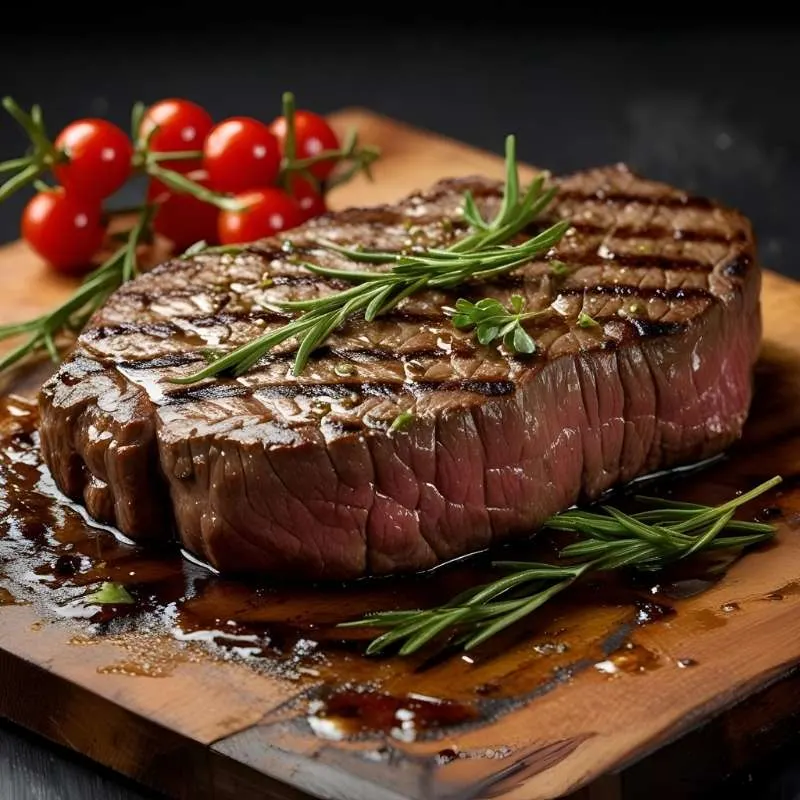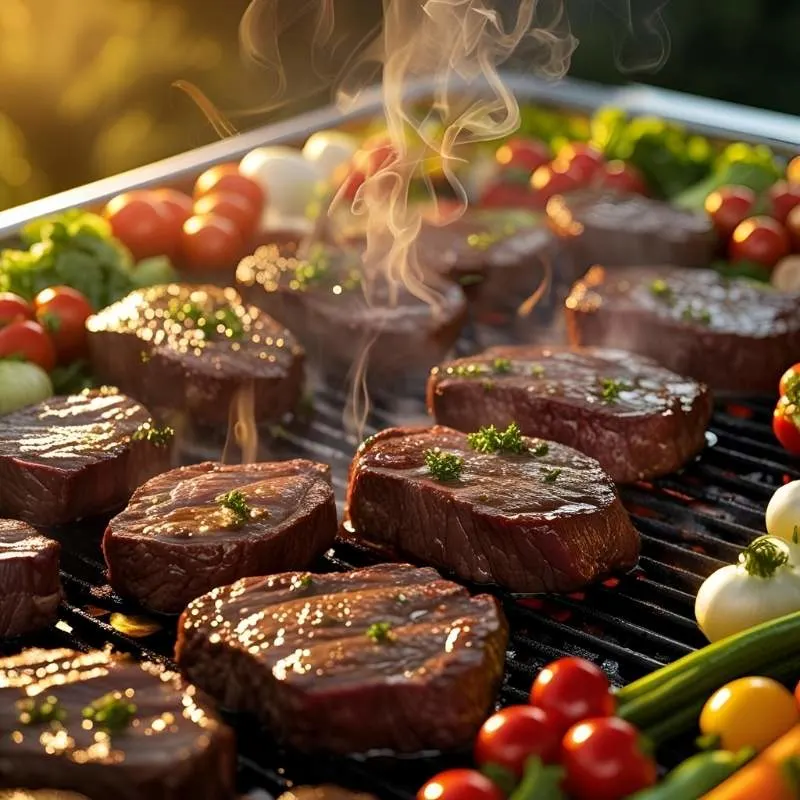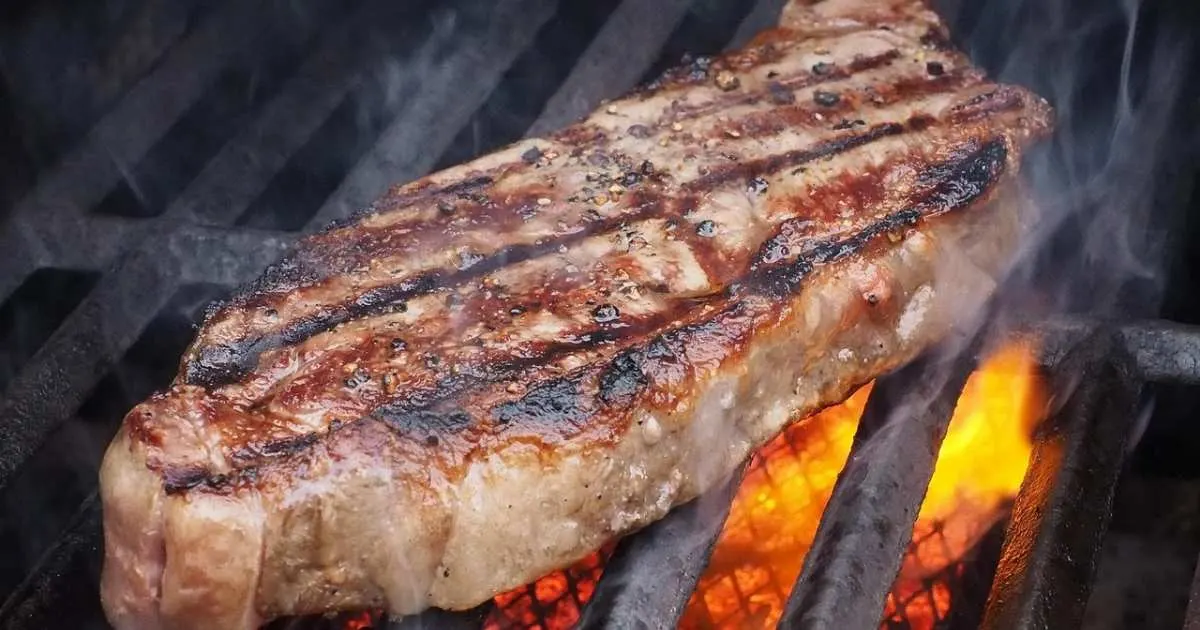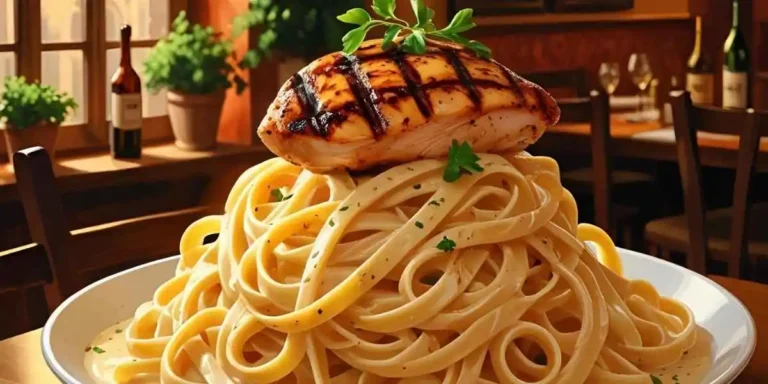Grill Beef Sirloin Like a Pro: Step-by-Step Grilling Tips
Table of Contents
Mastering the art of grilling beef sirloin can elevate your outdoor cooking experience. To achieve a perfectly cooked sirloin, it’s essential to understand the basics of grilling and the characteristics of different sirloin cuts.
You need to be aware of the various factors that contribute to a tender and flavorful dish, from the initial preparation to the final grilling stage. By following a step-by-step approach, you can ensure that your grilled sirloin turns out delicious every time.
Key Takeaways
- Understand the different cuts of beef sirloin for optimal grilling.
- Prepare your sirloin with the right marinades and seasonings.
- Grill your sirloin using the appropriate temperature and timing.
- Let the sirloin rest before slicing to retain juices.
- Cut the sirloin across the grain to ensure it stays as tender as possible.
Understanding Beef Sirloin Cuts
Grilling the perfect beef sirloin starts with selecting the right cut, and that’s where understanding the nuances of beef sirloin cuts comes in. Beef sirloin is derived from the rear section of the animal, near the hip, and is known for its tenderness and flavor. The cut can be divided into several sub-cuts, each with its unique characteristics.
Top Sirloin vs. Bottom Sirloin
Sirloin is generally classified into two primary types: top sirloin and bottom sirloin. Top sirloin is considered more tender and is often used in high-end steakhouses. It’s ideal for grilling and can be cooked to a variety of doneness levels. On the other hand, bottom sirloin is less tender but still packed with flavor, making it suitable for slow-cooking methods or slicing thinly for steak sandwiches.
Quality Grades of Beef
Beef quality is graded by the USDA based on factors like marbling, age, and tenderness.
Prime, Choice, and Select are the most widely recognized beef grades. Prime grade offers the highest level of marbling, making it exceptionally tender and flavorful. Choice grade ranks just below Prime, yet it still delivers excellent flavor and tenderness at a lower cost. For grilling, Prime or Choice grades are recommended for the best results.
Choosing the Perfect Cut for Grilling
When selecting a beef sirloin for grilling, opt for a cut that’s no less than 1 to 1.5 inches thick to promote even cooking. Adequate marbling is equally important to enhance flavor and tenderness. Consider your desired level of doneness and choose a cut accordingly. For a top sirloin filet recipe, a thicker cut with good marbling will yield the best results.
Essential Equipment for Grilling Beef Sirloin
Grilling beef sirloin like a pro begins with having the right grilling equipment. To achieve that perfect grill, you’ll need to consider the type of grill, the tools you use, and how you monitor the temperature.
Grill Types and Their Advantages
The type of grill you use can significantly impact the flavor and texture of your beef sirloin. Gas grills are convenient and allow precise temperature control, whereas charcoal grills deliver a deep, smoky flavor. Electric grills are another option, ideal for those with limited outdoor space. Each type has its advantages, so choose one that fits your grilling style.
Must-Have Grilling Tools
Having the right tools is crucial for grilling beef sirloin. Essential tools include a grill brush for cleaning the grates, tongs or spatulas for flipping the sirloin, and grill gloves to protect your hands from heat. These tools will help you manage the grilling process efficiently.
Temperature Monitoring Devices
Monitoring the temperature is critical to grilling beef sirloin to the perfect doneness. Utilize a meat thermometer to monitor the sirloin’s internal temperature. Some grills come with built-in thermometers, but a separate thermometer can provide more accurate readings.
| Grill Type | Advantages |
|---|---|
| Gas Grill | Easy temperature control, quick heating |
| Charcoal Grill | Rich, smoky flavor, traditional grilling experience |
| Electric Grill | Compact, suitable for indoor or outdoor use, easy to clean |
Preparing Your Sirloin for the Grill
A well-prepared sirloin is the foundation of a great grilling experience, and there are a few steps you should follow to get it just right. Preparing your sirloin for the grill is a multi-step process that ensures your steak turns out flavorful and tender.
Proper Thawing Techniques
If your sirloin is frozen, it’s essential to thaw it properly to maintain its quality. The safest way to thaw your steak is in the refrigerator, allowing it to thaw slowly overnight. This technique helps avoid bacterial growth and promotes uniform thawing.. Alternatively, you can use the cold water thawing method, where you submerge the steak in a leak-proof bag in cold water, changing the water every 30 minutes.
Trimming and Tenderizing Tips
Trimming excess fat from your sirloin can help prevent flare-ups during grilling and promote even cooking.
Trim away any excess fat or connective tissue using a sharp knife. Tenderizing your sirloin can also enhance its texture. You can use a meat mallet to pound the steak gently or a tenderizer tool to pierce the meat, making it more receptive to seasonings.
Bringing Steak to Room Temperature
Prior to grilling, it’s important to allow the sirloin to reach room temperature. Take the steak out of the fridge and let it rest at room temperature for approximately 30 to 45 minutes. Doing so ensures more even cooking by minimizing the temperature difference between the meat’s interior and exterior.
Patting Dry for Perfect Searing
Pat your sirloin dry with paper towels, on both sides, before grilling. This step is vital for achieving a perfect sear, as excess moisture can prevent the formation of a nice crust. A dry surface allows for better browning and enhances the overall texture of the steak.
| Preparation Step | Purpose |
|---|---|
| Proper Thawing | Maintains quality and prevents bacterial growth |
| Trimming and Tenderizing | Prevents flare-ups and enhances texture |
| Bringing to Room Temperature | Ensures even cooking |
| Patting Dry | Achieves a perfect sear |
By following these steps, you’ll be well on your way to grilling a sirloin that’s both flavorful and tender. Thorough preparation is essential for achieving great results on the grill.
Seasoning Options for Beef Sirloin
The key to a mouth-watering beef sirloin lies in the seasoning, whether you’re a fan of simple flavors or complex spice blends. Seasoning can transform a good piece of meat into an exceptional dining experience. With various methods to choose from, you can tailor the flavor to your liking, making beef sirloin a versatile option for any meal.
Classic Salt and Pepper Approach
A timeless and straightforward method, seasoning with salt and pepper allows the natural flavors of the beef sirloin to shine. This classic approach is ideal for those who prefer a minimalist flavor profile or are looking to highlight the quality of the meat. By using freshly ground pepper and flaky salt, you can add depth without overpowering the beef.
Dry Rubs for Enhanced Flavor
Dry rubs offer a robust alternative, infusing the beef sirloin with a blend of spices, herbs, and sometimes sugars. These dry mixtures can be customized to suit any taste, from smoky and spicy to herby and aromatic. Applying a dry rub allows the seasonings to penetrate the surface of the meat, creating a flavorful crust when grilled.
Marinades and Their Effects


Marinades are liquid seasoning blends that not only add flavor but can also tenderize the beef sirloin. Acidic ingredients like vinegar or citrus juice help break down the proteins, making the meat more tender. Marinades can range from simple olive oil and herb mixtures to complex blends involving yogurt or wine, offering a wide range of flavor possibilities.
When to Apply Seasonings
The timing of seasoning application can significantly impact the final flavor. For dry rubs and simple salt and pepper seasoning, applying just before grilling is usually sufficient. However, for marinades, allowing the meat to sit for several hours or overnight can enhance the flavor and tenderize the meat. Understanding when to apply your chosen seasonings is crucial for achieving the best results.
How to Grill Beef Sirloin Perfectly
Perfectly grilling a beef sirloin is a skill that can be mastered with practice and the right guidance. To achieve a mouth-watering grilled sirloin, you need to pay attention to several key steps, from preheating your grill to determining when to remove the steak from the heat.
Preheating Your Grill Properly
Preheating your grill is a crucial step that ensures your beef sirloin cooks evenly. To preheat your grill properly, turn the burners to high heat and let it heat up for at least 10-15 minutes. You can test the heat by flicking a few drops of water onto the grates; if they sizzle and evaporate quickly, your grill is ready.
Direct vs. Indirect Heat Methods
When grilling beef sirloin, you have the option to use either direct or indirect heat. Direct heat involves placing the steak directly over the flames, which is ideal for achieving a nice sear. Indirect heat, on the other hand, involves cooking the steak away from the direct flames, which is better for cooking the steak through without burning the outside.
For a 1-inch thick sirloin, start with 2-3 minutes of direct heat per side to get a good sear, then move it to indirect heat to finish cooking to your desired level of doneness.
Flipping Techniques
Flipping your sirloin steak is an art that requires some finesse. It’s recommended to flip the steak only once or twice during the grilling process to prevent losing juices. Use a pair of tongs or a spatula to flip the steak gently, making sure not to press down on the steak, which can squeeze out the juices.
Managing Flare-ups
Flare-ups can be a challenge when grilling, especially when fat drips onto the flames. To manage flare-ups, keep a spray bottle of water handy to douse any sudden flames. You can also trim excess fat from the steak before grilling to minimize the risk of flare-ups.
“The key to a great grilled steak is not just the quality of the meat, but also how you handle it on the grill.”
— Grill Master
Determining When to Remove from Heat
Knowing when to remove your sirloin from the heat is crucial to achieving your desired level of doneness. Use a meat thermometer to check the internal temperature of the steak. For medium-rare, the internal temperature should be around 130°F – 135°F.
| Doneness Level | Internal Temperature (°F) |
|---|---|
| Rare | 120-125 |
| Medium Rare | 130-135 |
| Medium | 140-145 |
| Medium Well | 150-155 |
| Well Done | 160+ |
By following these steps and techniques, you’ll be well on your way to grilling beef sirloin like a pro. Remember, practice makes perfect, so don’t be discouraged if it takes a few tries to get it just right.
Temperature Guidelines for Different Doneness Levels
To ensure your grilled beef sirloin is cooked to perfection, it’s essential to follow specific temperature guidelines. The internal temperature of the meat is a more reliable indicator of doneness than cooking time, as it accounts for variations in thickness and grill temperature.
Rare to Well-Done Temperature Chart
A temperature chart can be a valuable tool when grilling beef sirloin. Here’s a general guideline for the internal temperatures corresponding to different levels of doneness:
| Doneness Level | Internal Temperature (°F) |
|---|---|
| Rare | 120-130 |
| Medium Rare | 130-135 |
| Medium | 140-145 |
| Medium Well | 150-155 |
| Well Done | 160+ |
Using Meat Thermometers Correctly
A meat thermometer is a crucial tool for ensuring your beef sirloin is cooked to a safe internal temperature. To use it correctly, insert the thermometer into the thickest part of the steak, avoiding any fat or bone. For an accurate reading, wait a few seconds until the temperature stabilizes.
- Use a digital thermometer for the most accurate readings.
- Make sure the thermometer is not touching any bone or fat.
- Check the temperature in multiple places for thicker steaks.
The Touch Test Method
While not as precise as a thermometer, the touch test can be a useful alternative. By pressing the steak gently with your finger, you can gauge its doneness based on its firmness:
- Rare: feels soft and squishy.
- Medium Rare: feels firmer than rare but still yielding.
- Medium: springs back quickly.
- Well Done: feels hard and doesn’t yield to pressure.
Combining the touch test with a thermometer will give you the best results.
Alternative Cooking Methods for Sirloin
Sirloin steak doesn’t have to be grilled to be delicious; alternative cooking methods can produce equally tasty results. If you’re looking for variety or don’t have access to a grill, you can achieve a mouth-watering sirloin using your oven or stovetop.
Cooking sirloin steak can be accomplished through various techniques, each offering unique benefits. Whether you’re aiming for a tender, juicy steak or a nicely seared exterior, there’s a method that suits your preferences.
Cooking Sirloin Steak in the Oven
Cooking sirloin steak in the oven is a straightforward and effective method. To start, preheat your oven to 400°F (200°C). Season the steak as desired, then place it on a baking sheet lined with parchment paper or a lightly oiled broiler pan. Cook the steak in the oven for 10-15 minutes, or until it reaches your desired level of doneness. Use a meat thermometer to check for internal temperatures.
Here’s a simple guideline for cooking sirloin steak in the oven:
| Doneness Level | Internal Temperature | Cooking Time |
|---|---|---|
| Rare | 130-135°F | 8-12 minutes |
| Medium Rare | 135-140°F | 10-14 minutes |
| Medium | 140-145°F | 12-16 minutes |
Pan-Searing Techniques for Top Sirloin
Pan-searing is another excellent way to cook top sirloin steak. It allows for a nice crust to form on the outside while keeping the inside juicy. To pan-sear, heat a skillet or cast-iron pan over high heat. Add a small amount of oil to the pan, then place the steak in it. Sear the steak for 2-3 minutes on each side, depending on the thickness and your desired level of doneness. Finish with a compound butter or a sprinkle of herbs for added flavor.
“A good steak is all about the balance of flavors and textures. Pan-searing achieves that perfectly.” –
Chef’s Insight
Combining Methods: Grill to Oven Finish
For a hybrid approach, you can grill the sirloin steak briefly to get a nice sear, then finish it in the oven to achieve the desired doneness. This method combines the best of both worlds, offering a charred exterior and a tender interior. Grill the steak for 2-3 minutes per side, then transfer it to a preheated oven at 300°F (150°C) to finish cooking to your liking.
By exploring these alternative cooking methods, you can enjoy a delicious sirloin steak tailored to your taste preferences, whether you prefer the ease of oven cooking, the crust of pan-searing, or the hybrid approach of grilling and oven finishing.
Top Sirloin Filet Recipes and Variations
From classic flavors to innovative twists, explore the world of top sirloin filet recipes. Top sirloin filet is a versatile cut that can be prepared in numerous ways, making it perfect for any meal. Whether you’re looking for a simple yet elegant dish or something more adventurous, these recipes will guide you through the process.
Classic Grilled Sirloin with Herb Butter
A timeless recipe that never goes out of style, classic grilled sirloin with herb butter is a crowd-pleaser. To make it, you’ll need a top sirloin filet, herb butter (made with softened butter, parsley, thyme, and garlic), salt, and pepper. Grill the sirloin to your desired doneness, then top it with a pat of herb butter. This dish is perfect for a summer barbecue or a cozy dinner.
Marinated Asian-Style Sirloin
For a flavorful twist, try a marinated Asian-style sirloin. This recipe involves marinating the top sirloin filet in a mixture of soy sauce, honey, ginger, and garlic, then grilling it to perfection. Serve with steamed vegetables or a side of rice for a well-rounded meal.
Sirloin Tips with Mushroom Sauce
Sirloin tips with mushroom sauce offer a hearty and savory option. Cut the top sirloin into bite-sized pieces and sauté them with sliced mushrooms, onions, and a can of beef broth. Serve over egg noodles or mashed potatoes for a comforting meal.
Sirloin Kabobs with Vegetables
Sirloin kabobs with vegetables are perfect for a healthy and colorful meal. Alternate chunks of top sirloin with your favorite vegetables (such as bell peppers, onions, and cherry tomatoes) on skewers. Brush with olive oil, season with salt and pepper, and grill to your liking.
These top sirloin filet recipes showcase the cut’s versatility and are sure to inspire your next culinary creation. Experiment with different flavors and ingredients to find your new favorite dish.
Conclusion
Now that you’ve learned the essential steps and techniques for grilling beef sirloin, it’s time to put your skills to the test. By understanding the different cuts of beef sirloin, preparing your steak properly, and using the right grilling tips, you can achieve a perfectly cooked steak every time.
To grill beef sirloin like a pro, remember to preheat your grill correctly, use the right seasoning, and monitor the temperature to achieve your desired level of doneness. Don’t be afraid to experiment with different marinades and sauces to add extra flavor to your steak.
With practice and patience, you’ll become confident in your grilling abilities and be able to impress your friends and family with your culinary skills. So, fire up your grill, grab your favorite cut of beef sirloin, and start grilling your way to a delicious meal.
FAQ
What is the best way to cook a top sirloin filet?
To cook a top sirloin filet, you can grill it or use alternative methods such as oven roasting or pan-searing. Grilling is a popular method that yields a nice char on the outside while keeping the inside tender.
How do I cook sirloin steak in the oven?
To cook sirloin steak in the oven, preheat your oven to a high temperature, season the steak as desired, and then roast it in the oven until it reaches your desired level of doneness. Use a meat thermometer to check the internal temperature.
What is the difference between top sirloin and bottom sirloin?
Top sirloin is generally more tender and has a more delicate flavor than bottom sirloin. Bottom sirloin is often used for stir-fries and other dishes where it’s cooked quickly, while top sirloin is often grilled or roasted.
How do I know when my sirloin is cooked to the right temperature?
Use a meat thermometer to check the internal temperature of your sirloin. The recommended internal temperatures are: rare (130-135°F), medium-rare (135-140°F), medium (140-145°F), medium-well (145-150°F), and well-done (150°F and above).
Can I cook sirloin using indirect heat?
Yes, you can cook sirloin using indirect heat, which involves placing the steak away from the direct flames. This method is useful for thicker steaks or for achieving a more even cooking temperature.
How do I prevent flare-ups when grilling sirloin?
To prevent flare-ups, make sure to trim any excess fat from the sirloin, keep the grill grates clean, and avoid pressing down on the steak with your spatula. You can also use a grill mat or a piece of foil with holes to reduce flare-ups.
What are some seasoning options for beef sirloin?
You can season beef sirloin with a variety of ingredients, including salt, pepper, garlic, herbs, and spices. You can also use marinades or dry rubs to add flavor to the steak.
How do I cook a top sirloin steak?
To cook a top sirloin steak, you can grill, pan-fry, or oven roast it. Make sure to season the steak before cooking, and use a thermometer to check the internal temperature.







